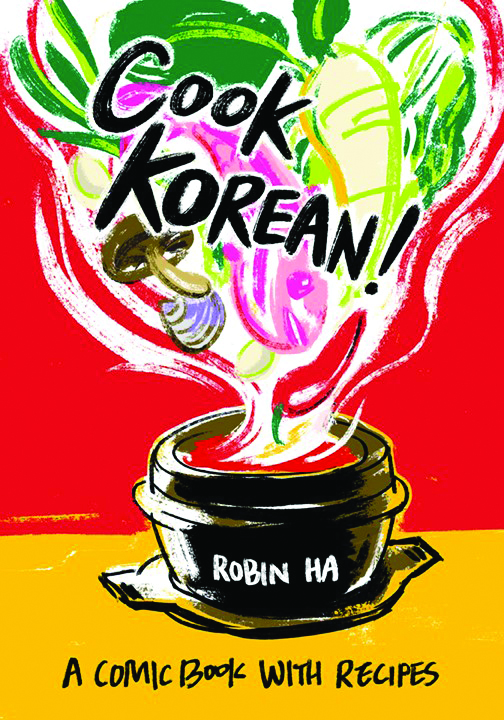Korean food gets playful in comic books
‘Cook Korean!: A Comic Book with Recipes’ was published in July 2016 and is available for purchase on Amazon.
April 29, 2017
While there are seemingly countless cookbooks out on the market, each written with a certain niche and aiming to set themselves apart from the rest on the shelf (or screen), “Cook Korean!”: A Comic Book with Recipes actually delivers. Author and illustrator Robin Ha has given the English-speaking world a vibrant and informative comic book-style cookbook, complete with passages that serve as welcoming introductions to Korean terminology and food culture.
Serving as narrator accompanying the reader through the chapters, Ha has created Dengki, a traditional-style Korean dress-wearing young lady. Visual learners will appreciate the fun sketches that span 1-3 pages per recipe, while the instructions accompanying are detailed and concise — especially helpful for those new to Korean cuisine.
Another charm the book has is Ha’s colorfully drawn culinary accounts of early life growing up in South Korea, leading up to her college era travels to Italy and relocation to New York, often injecting cheeky humor into her tales along the way.
Besides covering the basics of Korean cooking, such as key ingredients or types of bap (cooked rice), the 176-page paperback covers a portion of the over 100 varieties of vegetable side dishes known as banchan. Here you will find simple recipes for bean sprout salad and pan-fried tofu, as well as the bit more complex but legendary Dolsot Bibimbap — sizzling hot rice, veggies, proteins and spicy sauce cooked together in an earthenware pot.
More surprising may be the Acorn Jelly Salad recipe, which is strictly unique to Korean food. There is a chapter devoted to some varieties of kimchi, or traditional fermented/pickled vegetable dishes, which are a staple in the Korean diet. The most popular types are being made from napa cabbages and daikon radishes.
There is also a section concerning meat such as an intro on Korean barbeque, which is typically served in lettuce and/or perilla leaves. Ginseng Chicken Soup is also listed here, as Koreans prize ginseng for its medicinal properties.
The seafood chapter offers up specialties like the spicy Raw Fish Salad Bowl as well as accompaniments for seafood such as Tangy Seaweed Salad.
The Soups and Stews section offers up recipes which are healthy, though they each consist of meat, egg or seafood products. Even so, as with the other chapters of Ha’s book, she informs us that many of these recipes can be tweaked to make them vegan. For example, by substituting fish sauce for soy sauce, or omitting eggs. Porridges, which are mostly rice and rice flour based, vary with some consisting of interesting combinations of vegetables, nuts, seeds and fruit.
The Korean party food of Japchae, or Sweet Potato Noodles, can be found in the Noodles and Rice Cakes section along with an education on the different types of rice cakes. We hear about rice cakes again in the snacks section, where they are renowned as one of the kings of Korean street food in their various forms and preparations.
There is even a wrap-up chapter giving a nod to Korean fusion, since the influence and ingredients stemming from other countries seems to have taken over the world at large, and Korea is no different in this way.
With a large portion of the population being of imbibing age, there should be some mention of what Ha calls “The Irish of Asia.” Korean people have their own traditional alcoholic beverages such as Anju, as well as unspoken drinking rules and rituals which apply to social drinking scenarios.
In short, this book is a delight for those who love Korean food as well as a fun introduction for those who may be new to it. Ha’s passion for cooking is conveyed in an unassuming, practical, and artistic manner which can be contagious in a most welcome and quirky way.







